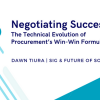For more than 20 years, organisations have been outsourcing the management of their contingent workforce in part or in full. The Managed Service Provider (MSP) market now represents *more than $130 billion of spend under management and thousands of third-party agencies are embedded within the global supply-side ecosystem. The core MSP objectives of visibility, control and savings are now largely viewed as hygiene factors and many client/MSP relationships have matured through multiple contract cycles.
So, with all that said, you would expect to find an extensive MSP client population in which talent management excellence is the norm, procurement professionals can boast of having the optimal cost/supplier profile in place, and hiring manager communities have nothing but love and affection for the processes and policies that are embedded within their organisation’s MSP program.
Unfortunately, despite years of market evolution, that reality is still a long way off.
While many programs have been through multiple contract cycles, internal adoption is still disappointingly low. The surface has barely been broken when it comes to including outcome-based talent via a statement of work and using predictive analytics to proactively manage demand exists on a “we’ll get around to it at some point” wish list. The incentive for (real) innovation is trapped inside the straitjacket of an outdated funding model—technological advances are not being sufficiently exploited and all too often the price of talent is still considered more important than talent outcomes.
It doesn’t have to be this way and it shouldn’t. However, the challenge for MSP providers is that too few clients are (genuinely) knowledgeable, or accepting, of the reality of what it takes to run a thriving program. Therefore, they often are unaware of the impact that this lack of understanding will have on the value that their MSP is able to deliver.
In my experience, existing MSP clients should address the following five questions:
- Are we giving our MSP enough visibility into our overall talent strategy and projected demand?
In today’s environment, if an MSP can operate ahead of a client’s talent needs, then it is more likely to secure the right talent at the right time. This isn’t rocket science, but it’s really the exception rather than the rule that client-side program leads share the sort of meaningful workforce and budgetary data that enables MSPs to plan effectively.
Furthermore, the often-quoted rationale that information is only worth sharing with the MSP once it is definitive otherwise it causes abortive effort, is simply not true. The cost to an MSP of chasing hard-to-find talent at short notice far outweighs the cost of refining plans as they go, even if some of those plans never come to fruition.
-
Are we leveraging the full breadth of our MSP’s supply market knowledge and, most importantly, giving licence to act on it?
It amazes me that clients engage MSPs to manage their talent supply network but then give them little to no latitude to do any actual management! The concept of lifting and shifting all existing suppliers into a newly established program, which often contains suppliers that are poor performers or not regularly engaged, doesn’t pass any reasonable test of sensible business management. If you choose an MSP solution because you need better knowledge of the talent supply marketplace then let the MSP design the right supplier mix and give it the licence to swap suppliers in and out. It doesn’t mean that your historical suppliers will be unjustly eliminated, it just means that their performance and long-term value will be judged more definitively, which can only be a good thing if you want a better talent supply network.
-
Has the proportion of contingent talent sourced within our MSP program materially expanded year on year, including outcome-based talent?
The primary goal of every program should be to act as the engagement vehicle for all types of non-permanent talent. To make this happen, the client-side MSP program leads must view themselves as “enablers” of work rather than “controllers” of incoming talent. This enabler mindset demands a variety of different commercial flows within the program design, depending on the type of talent engaged. It requires the MSP to work closely with the hiring/engagement managers to guide decision-making on what type of talent is appropriate to different types of work. They (the client side lead) will work collaboratively with their MSP to deploy a range of marketing techniques that ‘sells’ the benefits of their program internally and users will see value in the program because they will feel it has been designed to support their needs wherever and whenever they arise.
In contrast, the controller mindset is wired to first and foremost seek consistency of process and compliance. They believe that to obtain widespread adoption the program will need to be mandated and the way to deliver year-on-year business benefit (usually only measured by cost savings and cycle times) will be to restrict the amount of choice available to the hiring/engagement managers rather than liberate it. Controllers consider some types of talent, for example strategic consultancy, as being far too sensitive and difficult to source via the program and are likely to be more domineering in the way they manage the business relationship with the MSP.
-
Are we the most attractive destination of choice for the best contingent talent?
In today’s world, talent has more choices than ever before when it comes to where they work, the kind of work they do and who they work for. The growth of the gig economy and the impact of generational differences means that the strength of your customer value proposition is critical to finding and retaining the best contingent talent for your organisation. Your MSP should advise you on how attractive you are as a talent destination so you can build cross-functional initiatives that comprise procurement/HR and the hiring/engagement manager community (and in some cases representatives of your C-suite) to constantly keep this under review and front of mind.
-
Is our MSP making enough money to develop and test new ideas and innovations?
Let’s reflect for a minute. One of your own customers comes to you and says they want you to invest a six-figure sum upfront to implement new technology, processes and procedures within their organisation. Plus, you will need to fully fund and deploy a dedicated expert program management team to oversee the use of this new infrastructure.
The implementation , which could take several months, will not be directly paid for by the customer. Instead they will allow you to earn a tiny percentage of the invoices billed by a raft of third parties that will use the technology, processes and systems that you have put in place. However, you can only add that percentage and earn that income when the customer engages those third parties, which may be ad hoc, regular or never. The customer will not make any contractual guarantee to spend enough money with these third parties for you to recover your up-front investment within a reasonable period. The customer will also not make any guarantee that you will recover the recurring cost of the program management team, despite demanding ever more from them once the program has gone live.
Would your CFO think that was a great opportunity? Do you?
This scenario is what is known as the supplier-funded MSP model and it has become the de facto commercial approach in the industry. The merits of this funding model are an article in itself, so in the meantime, be realistic about the income that your MSP generates from the spend they manage on your behalf. If you are tracking on or beyond the original spend/volume forecast, then your MSP should (provided you have not driven their fee down to a ridiculously low level) be making enough return to invest in new ideas. If you are tracking below original forecast, then your MSP will not just question the viability of funding further innovation, more likely they will be questioning the viability of the entire program.
As the 19th century critic John Ruskin once said “It's unwise to pay too much, but it's worse to pay too little. When you pay too much, you lose a little money - that's all. When you pay too little, you sometimes lose everything, because the thing you bought was incapable of doing the thing it was bought to do.”









